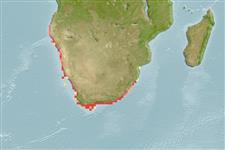>
Mugiliformes (Mullets) >
Mugilidae (Mullets)
Etymology: Chelon: Greek, chelone = turtle (Ref. 45335).
Eponymy: Sir John Richardson (1787–1865) was a Scottish naval surgeon, naturalist and Arctic explorer. [...] (Ref. 128868), visit book page.
Environment: milieu / climate zone / profondeur / distribution range
Écologie
marin; eau douce; saumâtre démersal; catadrome (Ref. 46888). Subtropical; 16°S - 36°S
Southeast Atlantic: South African coastal waters from Walfish Bay to Natal.
Length at first maturity / Taille / Poids / Âge
Maturité: Lm 25.0 range ? - ? cm
Max length : 40.5 cm TL mâle / non sexé; (Ref. 3573); common length : 30.0 cm TL mâle / non sexé; (Ref. 2830)
Épines dorsales (Total) : 5; Rayons mous dorsaux (Total) : 8 - 9; Épines anales: 3; Rayons mous anaux: 9.
Body shape (shape guide): fusiform / normal.
Found in coastal waters, mainly off rocky points and sandy beaches; may enter estuaries which serve as nursery areas (Ref. 27121). Feed mainly on diatoms and detritus, but also on planktonic crustaceans (Ref. 27121). Oviparous, eggs are pelagic and non-adhesive (Ref. 205). A primary target species of the inshore net fishery and much of it is sold salted and dried and known as 'bokkoms'. It is also an important exhibit species in public aquaria in South Africa. It is parasitised by the monogenean Gyrodactylus molweni on the external body surface (Ref. 124050).
Life cycle and mating behavior
Maturité | Reproduction | Frai | Œufs | Fécondité | Larves
Smith, M.M. and J.L.B. Smith, 1986. Mugilidae. p. 714-720. In M.M. Smith and P.C. Heemstra (eds.) Smiths' sea fishes. Springer-Verlag, Berlin. (Ref. 4393)
Statut dans la liste rouge de l'IUCN (Ref. 130435: Version 2025-1)
Menace pour l'homme
Harmless
Utilisations par l'homme
Pêcheries: commercial; Aquarium: Aquariums publics
Outils
Articles particuliers
Télécharger en XML
Sources Internet
Estimates based on models
Preferred temperature (Réf.
123201): 14.8 - 27, mean 24.8 °C (based on 56 cells).
Phylogenetic diversity index (Réf.
82804): PD
50 = 0.5010 [Uniqueness, from 0.5 = low to 2.0 = high].
Bayesian length-weight: a=0.01096 (0.00599 - 0.02007), b=2.95 (2.80 - 3.10), in cm total length, based on LWR estimates for this species & Genus-body shape (Ref.
93245).
Niveau trophique (Réf.
69278): 2.4 ±0.16 se; based on food items.
Résilience (Réf.
120179): Milieu, temps minimum de doublement de population : 1,4 à 4,4 années (Preliminary K or Fecundity.).
Fishing Vulnerability (Ref.
59153): Low to moderate vulnerability (31 of 100).
🛈
Nutrients (Ref.
124155): Calcium = 53.2 [14.2, 311.9] mg/100g; Iron = 0.741 [0.382, 1.308] mg/100g; Protein = 18.2 [16.8, 19.7] %; Omega3 = 0.681 [0.307, 1.551] g/100g; Selenium = 7.2 [3.0, 17.9] μg/100g; VitaminA = 11.3 [3.4, 37.6] μg/100g; Zinc = 0.691 [0.433, 1.097] mg/100g (wet weight);
